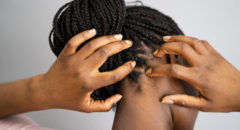
Seborrheic dermatitis can be a frustrating and persistent skin condition. Whether it’s the red, flaky patches on your scalp or the greasy-looking scales around your nose, dealing with this condition can be uncomfortable and embarrassing. But don’t worry! With the right treatments and strategies, you can get relief fast and keep those flare-ups under control.
In this article, we’ll explain what seborrheic dermatitis is, why it happens, and—most importantly—how you can manage it quickly and effectively.
What is Seborrheic Dermatitis?
Seborrheic dermatitis is a chronic skin condition that often targets oily areas of your body, like the scalp, face, chest, and upper back. It typically causes:
- Red, inflamed skin
- Oily or greasy scales
- Flaky skin that looks like dandruff
- Itchiness that can range from mild to severe
You might be familiar with terms like “dandruff” or “cradle cap” (in infants), which are forms of seborrheic dermatitis. The condition is not contagious but can cause discomfort and affect your self-esteem.
What Causes Seborrheic Dermatitis?
There’s no single cause, but experts believe seborrheic dermatitis happens due to a combination of factors, such as:
- Overgrowth of yeast (Malassezia): A type of yeast that normally lives on the skin can grow too much in oily areas, leading to irritation and inflammation.
- Excess oil production: The condition often appears in areas with a lot of sebaceous (oil) glands.
- Genetic factors: It can run in families.
- Stress and fatigue: Stress can trigger flare-ups or make symptoms worse.
- Cold or dry weather: Climate changes can also be a factor, with symptoms often worsening in winter.
Certain conditions, like Parkinson’s disease and a weakened immune system, are also associated with more severe cases of seborrheic dermatitis.
Fast Relief: How to Treat Seborrheic Dermatitis
Now, let’s dive into how you can get quick relief from seborrheic dermatitis. The goal is to reduce inflammation, clear up the scales, and manage flare-ups. Below are some of the most effective treatments that offer fast results.
1. Medicated Shampoos for Scalp Relief
If seborrheic dermatitis affects your scalp, over-the-counter medicated shampoos can provide fast relief. Look for ingredients like:
- Ketoconazole: A powerful antifungal that targets yeast overgrowth.
- Selenium sulfide: Reduces excess oil and tackles Malassezia yeast.
- Zinc pyrithione: Soothes inflammation and has antifungal properties.
- Salicylic acid: Helps remove scales by softening and loosening dead skin.
Use these shampoos 2-3 times per week, massaging them into your scalp and leaving them on for 5-10 minutes before rinsing. This ensures the active ingredients have time to work.
2. Topical Antifungal Creams
For seborrheic dermatitis on the face or body, topical antifungal creams such as ketoconazole or clotrimazole can provide quick relief. These creams work by reducing the yeast levels on your skin, which helps to decrease inflammation and scaling.
Apply the cream to affected areas once or twice daily, depending on your doctor’s recommendation. You should notice an improvement within a few days.
3. Steroid Creams for Fast Inflammation Reduction
When the inflammation is severe, doctors may recommend a short course of low-potency corticosteroid creams (e.g., hydrocortisone). These creams are effective at reducing redness, swelling, and itching quickly. However, because steroids can thin the skin if used long-term, they are usually prescribed for only a few days at a time.
Make sure to apply the steroid cream as directed and only use it in the areas where the inflammation is most pronounced.
4. Home Remedies for Soothing Relief
In addition to medicated treatments, several home remedies can help soothe symptoms of seborrheic dermatitis and speed up recovery:
- Tea tree oil: This natural antifungal has been shown to reduce inflammation and yeast on the skin. You can dilute a few drops of tea tree oil with a carrier oil (like coconut oil) and apply it to affected areas.
- Aloe vera gel: Known for its soothing properties, aloe vera can calm irritated skin and help reduce redness.
- Apple cider vinegar: Diluted apple cider vinegar may help restore your skin’s natural pH and reduce yeast overgrowth. Apply it as a rinse on the scalp or gently dab onto affected areas of the skin.
While these remedies may not be as fast-acting as medicated treatments, they can provide gentle relief, especially when combined with other therapies.
5. Moisturize Regularly
Keeping your skin hydrated is essential for managing seborrheic dermatitis. Use a non-greasy, hypoallergenic moisturizer to prevent dryness and reduce scaling. Products containing ceramides or hyaluronic acid can help maintain the skin’s barrier function, keeping moisture in and irritants out.
Be sure to choose a moisturizer that is non-comedogenic (won’t clog pores) to avoid aggravating the condition.
6. Manage Stress and Lifestyle Factors
Stress is a well-known trigger for seborrheic dermatitis flare-ups. Practicing stress-reducing techniques like yoga, meditation, or deep breathing exercises can help keep your symptoms under control.
Additionally, paying attention to your diet and getting enough sleep can make a difference in how often flare-ups occur.
Long-Term Maintenance: Preventing Future Flare-ups
While getting fast relief is essential, seborrheic dermatitis is a chronic condition that tends to come and go. To reduce the frequency of flare-ups, consider these long-term strategies:
- Use medicated shampoos regularly (even when symptoms are not present) to prevent buildup.
- Maintain a regular skincare routine, cleansing with mild, non-irritating products and moisturizing daily.
- Stay ahead of triggers like stress, cold weather, and hormonal changes.
If your symptoms are persistent or severe, consult a dermatologist. They can provide tailored advice and treatments to manage your condition effectively.
Seborrheic dermatitis may be chronic, but with the right treatment, you can quickly find relief from symptoms like itching, redness, and flaky skin. From medicated shampoos and antifungal creams to soothing home remedies, there are plenty of options to help you manage flare-ups fast.
By taking proactive steps to care for your skin and manage stress, you can keep seborrheic dermatitis under control and enjoy healthier, more comfortable skin every day.








